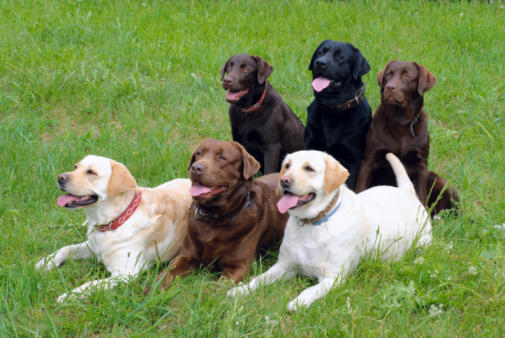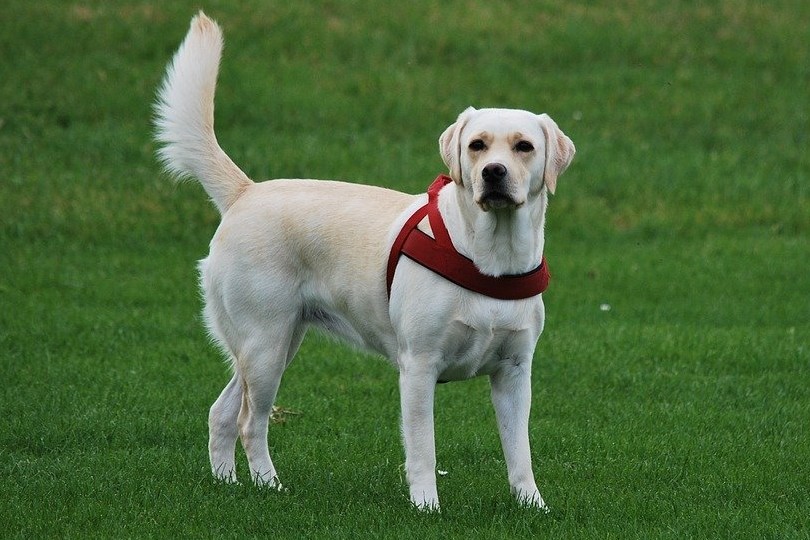The Labrador Retriever, Labrador, or Lab is a medium-large breed of retriever-gun dog. The Labrador is the most popular breed of dog in many countries around the world.
A favourite disability assistance breed in many countries, Labradors are frequently trained to aid those with blindness or autism, act as a therapy dog, or perform screening and detection work for law enforcement and other official agencies. The breed is best known for their obedience, loyalty, and playful composure. Additionally, they are prized as sporting and hunting dogs. Originally used in Newfoundland, as fishing dogs, they would help bring in the fishing nets and retrieve fish that had gotten away.
In the 1830s, the 10th Earl of Home and his nephews the 5th Duke of Buccleuch and Lord John Scott had imported progenitors of the breed from Newfoundland to Europe for use as gundogs. Another early advocate of these Newfoundland dogs, or Labrador Retrievers as they later became known, was the 2nd Earl of Malmesbury who bred them for their expertise in waterfowling.
During the 1880s, the 3rd Earl of Malmesbury, the 6th Duke of Buccleuch and the 12th Earl of Home collaborated to develop and establish the modern Labrador breed. The dogs Buccleuch Avon and Buccleuch Ned, given by Malmesbury to Buccleuch, were mated with bitches carrying blood from those originally imported by the 5th Duke and the 10th Earl of Home. The offspring are considered to be the ancestors of modern Labradors.
Appearance
Labradors are a medium-large breed, with males typically weighing 29–36 kg (65–80 lb) and females 25–32 kg (55–70 lb). The majority of the characteristics of this breed, except for colour, are the result of breeding to produce a working retriever.
As with some other breeds, the Conformation (typically “Show”, “English” or “bench”) and the Field (typically “Working” or “American”) lines differ, although both lines are bred in both countries. In general, however, Conformation Labradors tend to be bred as medium-sized dogs, shorter and stockier with fuller faces and a slightly calmer nature than their Field counterparts, which are often bred as taller, lighter-framed dogs, with slightly less broad faces and a slightly longer nose. However, Field Labradors should still be proportional and fit within American Kennel Club standards. With Field Labradors, excessively long noses, thin heads, long legs, and lanky frames are not considered standard. These two types are informal and not codified or standardised; no distinction is made by the AKC or other kennel clubs, but the two types come from different breeding lines. Australian stock also exists; though not seen in the West, they are common in Asia. These dogs are also very good with children.
The breed tends to shed hair twice annually or regularly throughout the year in temperate climates. Some Labradors shed considerably; however, individual Labradors vary. Labrador hair is usually short and straight, and the tail is quite broad and strong. The webbed toes of the Labrador Retriever make them excellent swimmers. The webbing between their toes can also serve as a “snowshoe” in colder climates and keep snow from balling up between their toes—a condition that can be painful to other breeds with hair between the toes. Their interwoven coat is also relatively waterproof, providing more assistance for swimming.
Temperament

The AKC describes the Labrador’s temperament as a kind, pleasant, outgoing and tractable nature. Labradors’ sense of smell allows them to home in on almost any scent and follow the path of its origin. They generally stay on the scent until they find it. Navies, military forces and police forces use them as detection dogs to track down smugglers, thieves, terrorists and black marketers. They are known to have a very soft feel to the mouth as a result of being bred to retrieve game such as waterfowl. They are prone to chew objects (though they can be trained to abandon this behaviour).
Labradors have a reputation as a very even-tempered breed and an excellent family dog. This includes a good reputation with children of all ages and other animals. Some lines, particularly those that have continued to be bred specifically for their skills at working in the field (rather than for their appearance), are particularly fast and athletic. Their fun-loving boisterousness and lack of fear may require training and firm handling at times to ensure it does not get out of hand—an uncontrolled adult can be quite problematic. Females may be slightly more independent than males. Labradors mature at around three years of age; before this time they can have a significant degree of puppy-like energy, often mislabelled as being hyperactive. Because of their enthusiasm, leash-training early on is suggested to prevent pulling when full-grown. Labradors often enjoy retrieving a ball endlessly (often obsessively) and other forms of activity (such as agility, frisbee, or flyball).
Although they will sometimes bark at noise, especially noise from an unseen source (“alarm barking”), Labradors are usually not noisy or territorial. They are often very easygoing and trusting with strangers and therefore are not usually suitable as guard dogs.
Labradors as a breed are curious and exploratory and love company, following both people and interesting scents for food, attention, and novelty value. In this way, they can often “vanish” or otherwise become separated from their owners with little fanfare. As a breed, they are highly intelligent and capable of intense single-mindedness and focus if motivated or their interest is caught. Therefore, with the right conditions and stimuli, a bored Labrador could “turn into an escape artist par excellence“. Many dogs are also stolen. Because of their curious nature and ability to “vanish,” along with the risk of being stolen, a number of dog clubs and rescue organisations (including the UK’s Kennel Club) consider it good practice that Labradors be microchipped, with the owner’s name and address also on their collar and tags.
The steady temperament of Labradors and their ability to learn to make them an ideal breed for search and rescue, detection, and therapy work. They are a very intelligent breed. They are ranked No. 7 in Stanley Coren’s The Intelligence of Dogs, making it one of the brightest dogs out of 138 breeds tested. The AKC describes the breed as an ideal family and sporting dog. Their primary working role in the field continues to be that of a hunting retriever.
Use as working dogs

Labradors are an intelligent breed with a good work ethic and generally good temperaments. Common working roles for Labradors include hunting, tracking and detection (they have a great sense of smell which helps when working in these areas), disabled-assistance, carting, and therapy work. Approximately 60–70% of all guide dogs in Canada are Labradors; other common breeds are Golden Retrievers and German Shepherds. Labrador Retrievers have proven to have a high success rate at becoming guide dogs. A study was recently done on how well four different breeds (Labrador Retriever, Golden Retriever, Labrador Retriever/Golden Retriever Mix, and German Shepherds) trained to become guide dogs. In this experiment, German Shepherds had the highest chance of not completing it. Labrador Retrievers and Labrador Retriever/Golden Retriever Mix had the highest success rate. However, German Shepherds and Golden Retrievers had a higher success rate after going through longer training than the training required for Labrador Retrievers.
Labradors are noted for their ability to tolerate cold water
Labradors are powerful and indefatigable swimmers noted for their ability to tolerate the coldest of water for extended periods of time. Their ability to work quietly alongside hunters while watching for birds to fall from the sky, marking where they land, and then using their outstanding nose to find and retrieve dead or wounded birds has made them the king of waterfowl retrievers. They are also used for pointing and flushing and make excellent upland game hunting partners.
The high intelligence, initiative and self-direction of Labradors in working roles are exemplified by dogs such as Endal, who is trained to, if need be, put his wheelchair-bound human in the recovery position, cover him with a blanket, and activate an emergency phone. A number of Labradors have also been taught to assist their owner in removing money and credit cards from ATMs with prior training.
The breed is used in water rescue/lifesaving. It continues in that role today, along with the Leonberger, Newfoundland and Golden Retriever dogs; they are used at the Italian School of Canine Lifeguard.
